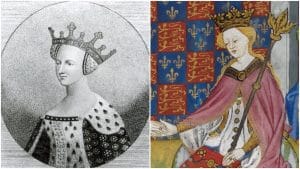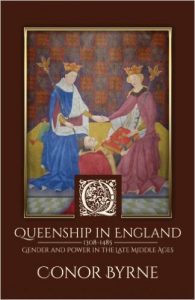 Thank you to author and historian Conor Byrne for joining us today with this guest article. I know many of you enjoyed his book on Katherine Howard so you’ll be pleased to know that his latest book Queenship in England is a kindle countdown deal from 2-4 May. 99c/99p is a bargain for this book.
Thank you to author and historian Conor Byrne for joining us today with this guest article. I know many of you enjoyed his book on Katherine Howard so you’ll be pleased to know that his latest book Queenship in England is a kindle countdown deal from 2-4 May. 99c/99p is a bargain for this book.
Over to Conor…
Edward IV’s secret marriage to the Lancastrian widow Elizabeth Wydeville in 1464 was controversial for a number of reasons, as has long been recognised by historians. What was perhaps most striking about their union, however, was that Elizabeth was the first Englishwoman to become queen of England since the Norman Conquest. Strikingly, her two immediate successors Anne Neville and Elizabeth of York were also Englishwomen, and as is well known, Elizabeth Wydeville’s grandson Henry VIII married four English brides. The marital choices of Edward IV, Richard III, Henry VII and Henry VIII, however, strayed from contemporary custom, in an age when monarchs were expected to wed royal spouses from foreign kingdoms. This custom proved to be highly influential during the Middle Ages and was only discarded in 1464, although later kings, including Henry VIII, resumed the practice of marrying foreign brides. So inexplicable was Edward IV’s choice of wife that rumours circulated that he had been bewitched into marrying the beautiful Elizabeth. In a worsening political climate that culminated in the Earl of Warwick’s rebellion against the king, it was alleged that both Elizabeth and her mother, Jacquetta of Luxembourg, were sorceresses.
My book Queenship in England: 1308–1485 Gender and Power in the Late Middle Ages examines the tenures of nine women who were married to English kings. Seven of them were foreigners, the exceptions being Elizabeth Wydeville and Anne Neville. Rather than being a traditional narrative biography of England’s medieval queens, my book is more of a study of the institution of queenship and its associated roles, including intercessor, patron, lord and household manager. It is especially interested in the often vexed relationship between gender and power as it operated at the heart of the English monarchy, and endeavours to shed light on informal avenues of power that were accessed by the consort in order to wield influence. Moreover, the fourteenth- and fifteenth-centuries can be regarded as a period of intermittent crisis, occasioned by political, economic and military tensions that resulted in war, rebellion and conspiracy and, on several occasions, in the usurpation of the king. Whether or not we can speak of a crisis of medieval kingship during the late Middle Ages is contentious, but if so, then it strikes me as worthwhile to consider whether – and how – this impacted on contemporary expectations of queenship, and whether queenship itself underwent change and development during a period of troubles.
The period that I am interested in means that the institution of English queenship is approached with the understanding that the occupant of that office was, aside from two occasions, foreign born. It is worth pointing out that the queen’s foreignness was not necessarily the principal factor governing her effectiveness – or otherwise – in conforming to, or challenging, contemporary expectations of queenship. However, it is also true that the foreign queen could experience difficulties that were not necessarily applicable to native consorts. For example, contemporaries expressed dissatisfaction with their queen if they believed her foreign entourage to be exercising a malign influence on her actions, or if they believed that the entourage was a financial burden on the crown. Joan of Navarre, wife of Henry IV, was vulnerable to accusations that her foreign servants betrayed the king’s counsel to his enemies and there were calls for their expulsion from the realm. A former duchess of Brittany, it is interesting that Henry’s subjects requested him to order the expulsion of all Frenchmen and Bretons from the kingdom, and two of Joan’s daughters from her first marriage may have been compelled to depart with them. Criticisms of the queen’s household seem to have arisen in especially unfavourable political, financial and military circumstances. Anne of Bohemia, who married Richard II in 1382, apparently struggled to govern her household effectively. Her attendant Agnes de Launcekrona, who had accompanied her from Bohemia, commenced a clandestine affair with Robert de Vere, earl of Oxford, and the earl later petitioned the pope to grant him an annulment of his marriage to Philippa de Coucy, cousin of the king. Rumours alleged that Anne had encouraged the pope to sanction the annulment in order for the earl to wed her maiden. The queen’s failure to protect Agnes’ honour and the suggestion that she was involved in the attempt to annul the marriage to a royal cousin did not reflect well on Anne.
The queenship of Margaret of Anjou sheds light on the tensions that could be encountered by a foreign consort during the late Middle Ages. Henry VI’s subjects do not appear to have interpreted his marriage favourably, for it was not perceived to bring substantial diplomatic or financial gains to the kingdom. Complaints were made that Margaret had arrived in the realm without ‘any peny profite, or foote of posession’, and England was imagined as the unsuspecting victim of corrupt French policies. The queen was criticised for her apparent decision to pressure her husband into ceding the territories of Maine and Anjou to the French, although her actions were likely influenced by the encouragement of her father and the king of France. As I note in Queenship in England: ‘In the early years of her marriage, Margaret’s actions were largely conventional. Had it not been for the onset of her husband’s illness and the resulting civil strife, she might have been remembered and praised as a conscientious, efficient and dutiful consort.’ The onset of civil war, however, required Margaret to play a more politically active role than contemporaries expected of the queen, but in doing so, it rendered her vulnerable to accusations of treachery, accentuated in part by her foreignness. Alongside rumours of her sexual immorality, it was alleged that Margaret ‘ruled the realm as she liked’, an allegation that was informed by, and played on, residual English fears that their kingdom would be undermined, even ruined, by the malignant presence of their foreign consort. As is well known, these fears explicitly resurfaced when the first queen regnant Mary I made public her intent to marry Philip of Spain.
The collapse of Henry VI’s health and, by extension, authority meant that his consort was compelled to take an active role at the centre of government, but in doing so, she found herself vulnerable to allegations of sexual immorality and political treachery. The effectiveness of Yorkist propaganda, moreover, has ensured that Margaret of Anjou’s historical reputation continues to be dubious, the lingering image of her a vengeful, cruel and bloodthirsty woman responsible for decades of war and bloodshed. In contrast, while her status as an unpopular queen believed to favour her native realm and England’s ancient enemy, France, complicated Margaret’s tenure during her husband’s lifetime, the foreignness of her predecessors Joan of Navarre and Katherine of Valois rendered them especially vulnerable after the deaths of their husbands.
During her tenure as consort, evidence suggests that Joan enjoyed amicable relations with her stepchildren, including her husband’s heir Henry, who succeeded his father as Henry V in 1413. However, everything changed for Joan in 1419, when her stepson accused her of sorcery and ordered her arrest in a calculated bid to seize her lands in order to finance his wars with France and his impending marriage. As was noted earlier, the queen had been vulnerable to hostile accusations during her marriage to Henry IV, and after his death, she found herself without a powerful protector to safeguard her interests. As Paul Strohm notes, Joan ‘was an outpost of foreignness – and hence of suspicion – in an increasingly English and English-speaking milieu’. Her failure to produce children during her marriage to Henry, moreover, rendered her vulnerable during her stepson’s reign and meant that she lacked political relevance.
Similarly, Joan’s successor Katherine of Valois had every reason to regret her husband’s death in 1422. Deprived of the security that she had enjoyed as consort, salacious rumours circulated that the dowager queen was clandestinely involved with Edmund Beaufort and, later, Owen Tudor. Whether Katherine ever actually married Owen is open to debate. Traditionally the union has been romantically identified as one based on love, but it is also possible that Katherine sought a powerful protector to safeguard her position and uphold her interests during the reign of her son. She appears to have sought to resolve her precarious situation by remarrying, although her remarriage was forbidden by an act of Parliament. That Katherine feared the reaction of her son’s council explains why her marriage to Owen remained secret until after her death.
 Conor Byrne’s book Queenship in England: 1308–1485 Gender and Power in the Late Middle Ages is a Kindle Countdown deal on Amazon.com and Amazon UK from today until the end of 4th May 2017 meaning that it’s just 99c or 99p. Grab it while you can! Here are the links:
Conor Byrne’s book Queenship in England: 1308–1485 Gender and Power in the Late Middle Ages is a Kindle Countdown deal on Amazon.com and Amazon UK from today until the end of 4th May 2017 meaning that it’s just 99c or 99p. Grab it while you can! Here are the links:
- Amazon.com – http://amzn.to/2pApb0y
- Amazon UK – http://amzn.to/2p0yl3v
It is also available as a kindle book on the other Amazon sites and as a paperback. Here is the blurb:
“An interesting and accessible exploration of medieval queenship in relation to gender expectations.”
– Amy Licence, author of Catherine of Aragon: An Intimate Life of Henry VIII’s True Wife
“A very readable and thoroughly researched book that looks at the role of late medieval Queens of England in an original way.”
– Toni Mount, author of A Year in the Life of Medieval England
Between 1308 and 1485, nine women were married to kings of England. Their status as queen offered them the opportunity to exercise authority in a manner that was denied to other women of the time. This book offers a new study of these nine queens and their queenship in late medieval England.
Isabella of France, wife of Edward II
Philippa of Hainault, wife of Edward III
Anne of Bohemia, wife of Richard II
Isabelle of France, second wife of Richard II
Joan of Navarre, wife of Henry IV
Katherine of Valois, wife of Henry V
Margaret of Anjou, wife of Henry VI
Elizabeth Wydeville, wife of Edward IV
Anne Neville, wife of Richard III
The fourteenth- and fifteenth-centuries were frequently characterised by dynastic uncertainty and political tensions. Scholars have recognised that the kings who ruled during this time were confronted with challenges to their kingship, as new questions emerged about what it meant to be a successful king in late medieval England. This book examines the challenges faced by the queens who ruled at this time. It investigates the relationship between gender and power at the English court, while exploring how queenship responded to, and was informed by, the tensions at the heart of governance.
Ultimately Queenship in England questions whether a new model of queenship emerged from the great upheavals underpinning the fourteenth- and fifteenth-century polity.